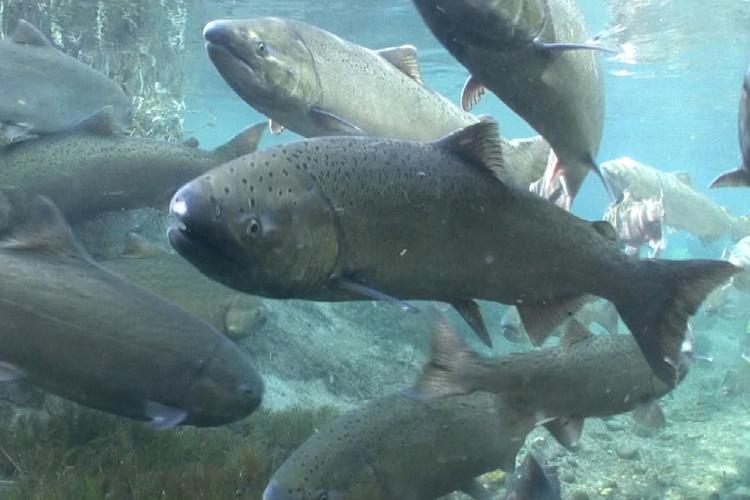In response to unprecedented declines in chum and Chinook salmon on the Yukon and Kuskokwim rivers, the Alaska Salmon Task Force was created by an act of Congress. Under the Act, the National Marine Fisheries Service, acting on behalf of the Secretary of Commerce, is required to convene an Alaska Salmon Research Task Force to identify data gaps and develop a collaborative science plan for sustainable management of salmon in Alaska.
Draft Alaska Salmon Research Task Force Report October 2023
The following is the initial DRAFT of our AKSRTF Report as of October 2023. Our goal is to keep the report to about 30 pages, but we will have appendices to capture all relevant information. To date, we have two appendices that include Existing Knowledge and Organizations engaged in salmon research in Alaska. We will continue to build the report based on AKSRTF input, the Arctic Yukon Kuskokwim Working Group report recommendations on research needs for the AYK Region, and Public Comment.
At this time, we are seeking Public Comment on: Existing Knowledge, Research Gaps, and Applied Research that is needed to better understand the increased variability and declining salmon returns in some regions of Alaska.
We greatly value your input in the development of this report. Comments on Existing Knowledge, Research Gaps, and Applied Research Needs can be given via this form.
Task Force Purpose and Objectives
The task force must review and report on research about Pacific salmon in Alaska, identify applied research needed to better understand salmon migration and declining salmon returns in some regions of Alaska, and support sustainable management of salmon.
The purposes of the Act are to:
- Ensure that Pacific salmon trends in Alaska regarding productivity and abundance are characterized and that research needs are identified
- Prioritize scientific research needs for Pacific salmon in Alaska
- Address the increased variability or decline in Pacific salmon returns in Alaska by creating a coordinated salmon research strategy
- Support collaboration and coordination for Pacific salmon conservation efforts in Alaska
Task Force Membership
As specified in the legislation, the Task Force will consist of 13 to 19 members.
The Secretary of Commerce will appoint a representative NOAA, the North Pacific Fishery Management Council, and the United States section of the Pacific Salmon Commission. The Secretary will also appoint between two and five representatives from each of the following categories, with due regard to differences in regional perspectives and experience:
- Residents of Alaska who possess personal knowledge of, and direct experience with, subsistence uses in rural Alaska (at least two representatives)
- Alaska fishing industry representatives throughout the salmon supply chain, including from directed commercial fishing, recreational fishing, charter fishing, seafood processors, salmon prohibited species catch (bycatch) users, or hatcheries
The Secretary will appoint five representatives who are academic experts in salmon biology, salmon ecology (marine and freshwater), salmon habitat restoration and conservation, or comprehensive marine research planning in the North Pacific.
The Governor of Alaska will appoint one representative from the State of Alaska who is knowledgeable about the State of Alaska’s salmon research efforts.
Task Force Workplan
Thirty days after convening the larger body, the task force will also form a work group focused on the Arctic-Yukon-Kuskokwim regions of Western Alaska consisting of no fewer than five representatives.
After 1 year, the task force will produce a report that describes the scientific review and recommendations on filling knowledge gaps that warrant further scientific inquiry.
NOAA Fisheries’ Alaska Fisheries Science Center is providing organizational and staff support for the Task Force.
| DATE | TITLE |
|---|---|
| June 28, 2023 | Task Force Meeting– Introductions and Tasks |
| July 27, 2023 | Task Force Meeting (virtual–open to public); Establish the ARCTIC YUKON KUSKOKWIM WORKING GROUP |
| September 19, 2023 | Task Force Meeting (virtual–open to public); Discuss report outline and progress toward existing knowledge and research gaps |
| November 14/15, 2023 | Task Force Meeting (Hybrid in Anchorage, AK–open to public); Day 1–(1/2 day) Report Existing knowledge and gaps (1/2 day) Public comment/testimony; Day 2–(1/2 day) Report Research Needs (1/2 day) Public comment/testimony. |
| January 25, 2024 | Task Force Meeting (virtual–open to public); Report on progress toward DRAFT Report |
| March 27, 2024 | Task Force Meeting (virtual–open to public) Report on DRAFT FINAL REPORT |
| May 22, 2024 |
Task Force Meeting (virtual – open to public) FINAL DRAFT of REPORT |
| June 27, 2024 | FINAL REPORT |



